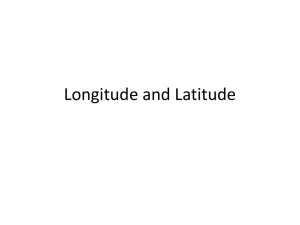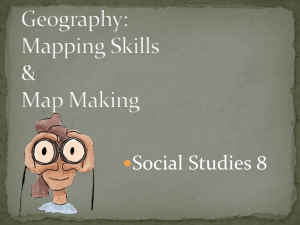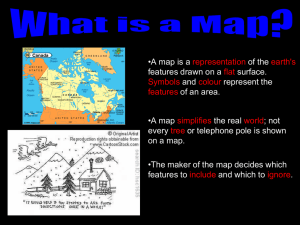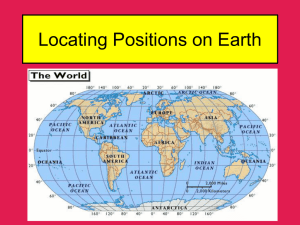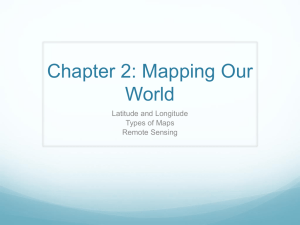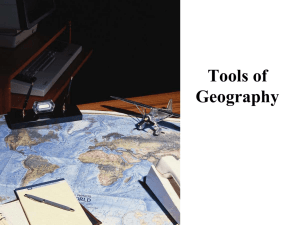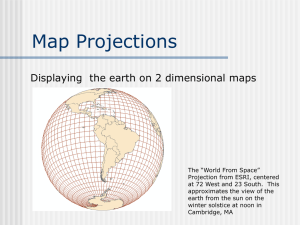08GWH GeoHB
advertisement
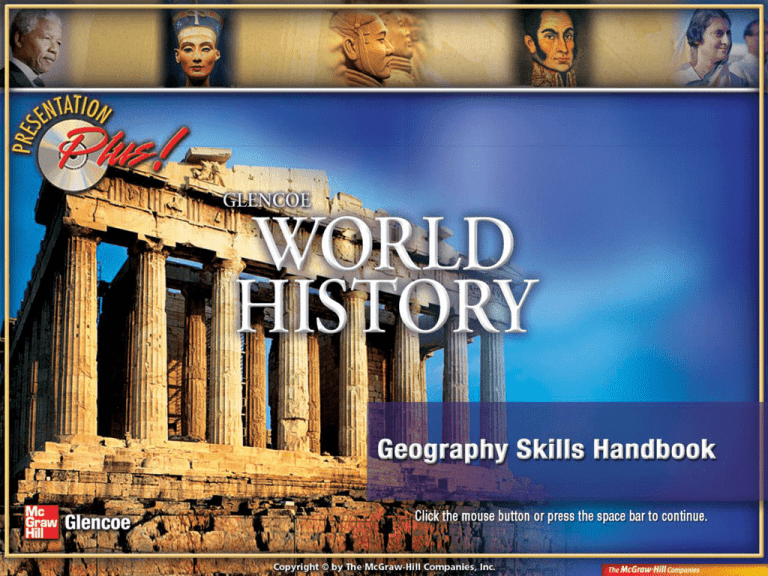
Globes and Maps Projections Determining Location Reading a Map Physical Maps Political Maps Thematic Maps Geographic Information Systems Globes and Maps • A globe is a scale model of the Earth that presents the most accurate depiction of geographic information such as area, distance, and direction. • A printed map is a symbolic representation of all or part of the planet. From 3-D to 2-D • To create maps that are not interrupted, mapmakers, or cartographers, use mathematical formulas to transfer information from the threedimensional globe to the two-dimensional map. Great Circle Routes • A great circle is an imaginary line that follows the curve of the Earth and represents the shortest distance between two points. • Traveling along a great circle is called following a great circle route. Projections • To create maps, cartographers project the round Earth onto a flat surface—making a map projection. • Distance, shape, direction, or size may be distorted by a projection. • The three basic categories of map projections are planar, cylindrical, and conic. Projections (cont.) Planar Projection A planar projection shows the Earth centered in such a way that a straight line coming from the center to any other point represents the shortest distance. Also known as an azimuthal projection, it is most accurate at its center. As a result, it is often used for maps of the Poles. Projections (cont.) Cylindrical Projection A cylindrical projection is based on the projection of the globe onto a cylinder. This projection is most accurate near the Equator, but shapes and distances are distorted near the Poles. Projections (cont.) Conic Projection A conic projection comes from placing a cone over part of a globe. Conic projections are best suited for showing limited eastwest areas that are not too far from the Equator. For these uses, a conic projection can indicate distances and directions fairly accurately. Common Map Projections Most general reference world maps are the Winkel Tripel projection. It provides a good balance between the size and shape of land areas as they are shown on the map. Even the polar areas are depicted with little distortion of size and shape. Common Map Projections (cont.) An interrupted projection resembles a globe that has been cut apart and laid flat. Goode’s Interrupted Equal-Area projection shows the true size and shape of Earth’s landmasses, but distances are generally distorted. Common Map Projections (cont.) The Robinson projection has minor distortions. The sizes and shapes near the eastern and western edges of the map are accurate, and outlines of the continents appear much as they do on the globe. However, the polar areas are flattened. Common Map Projections (cont.) The Mercator projection increasingly distorts size and distance as it moves away from the Equator. However, Mercator projections do accurately show true directions and the shapes of landmasses, making these maps useful for sea travel. Determining Location • The basic tool for answering the question “Where?” is location. • A grid system on maps and globes helps you find exact places on the Earth’s surface. • A hemisphere is one of the halves into which the Earth is divided. Most places are located in two of the four hemispheres. Determining Location (cont.) Latitude Lines of latitude, or parallels, circle the Earth parallel to the Equator and measure the distance north or south of the Equator in degrees. The Equator is measured at 0° latitude, while the Poles lie at latitudes 90°N (north) and 90°S (south). Parallels north of the Equator are called north latitude. Parallels south of the Equator are called south latitude. Determining Location (cont.) Longitude Lines of longitude, or meridians, circle the Earth from Pole to Pole. These lines measure distance east or west of the Prime Meridian at 0° longitude. Meridians east of the Prime Meridian are known as east longitude. Meridians west of the Prime Meridian are known as west longitude. The 180° meridian on the opposite side of the Earth is called the International Date Line. Determining Location (cont.) The Global Grid Every place has a global address, or absolute location. You can identify the absolute location of a place by naming the latitude and longitude lines that cross exactly at that place. For example, Tokyo, Japan, is located at 36°N latitude and 140°E longitude. For more precise readings, each degree is further divided into 60 units called minutes. Determining Location (cont.) Northern and Southern Hemispheres The diagram shows that the Equator divides the Earth into the Northern and Southern Hemispheres. Everything north of the Equator is in the Northern Hemisphere. Everything south of the Equator is in the Southern Hemisphere. Determining Location (cont.) Eastern and Western Hemispheres The Prime Meridian and the International Date Line divide the Earth into the Eastern and Western Hemispheres. Everything east of the Prime Meridian for 180° is in the Eastern Hemisphere. Everything west of the Prime Meridian for 180° is in the Western Hemisphere. Reading a Map Title Key Scale Bar Compass Rose Capitals Boundary Lines Cities Using Scale • All maps are drawn to a certain scale. • Scale is a consistent, proportional relationship between the measurements shown on the map and the measurement of the Earth’s surface. Using Scale (cont.) Small-Scale Maps A small-scale map, like this political map of France, can show a large area but little detail. Using Scale (cont.) Large-Scale Maps A large-scale map, like this map of Paris, can show a small area with a great amount of detail. Absolute and Relative Location • Absolute location is the exact point where a line of latitude crosses a line of longitude. • Relative location is the location of one place in relation to another. Physical Maps • A physical map shows the location and the topography, or shape of the Earth’s physical features. • A study of a country’s physical features often helps to explain the historical development of the country. Physical Maps (cont.) Water Features Landforms Relief and Elevation Political Features Political Maps • A political map shows the boundaries and locations of political units such as countries, states, counties, cities, and towns. • Many features depicted on a political map are human-made, or determined by humans rather than by nature. • Political maps can show the networks and links that exist within and between political units. Political Maps (cont.) Human-Made Features Physical Features Nonsubject Area Thematic Maps • Maps that emphasize a single idea or a particular kind of information about an area are called thematic maps. • There are many kinds of thematic maps, such as climate, natural vegetation, population density, and economic activities maps. Thematic Maps (cont.) Qualitative Maps Qualitative maps use colors, symbols, lines, or dots to show information related to a specific idea. Such maps are often used to depict historical information. Thematic Maps (cont.) Flow-Line Maps Flow-line maps illustrate the movement of people, animals, goods, and ideas, as well as physical processes like hurricanes and glaciers. Arrows are usually used to represent the flow and direction of movement. Geographic Information Systems • Most cartographers use computers with software programs called geographic information systems (GIS). • A GIS is designed to accept data from different sources — maps, satellite images, printed text, and statistics. • Cartographers then program the GIS to process the data and produce maps. • This technology allows cartographers to make maps—and change them—quickly and easily. globe a spherical representation of the Earth map a representation, usually on a flat surface, of the whole or part of an area cartographer one that makes maps great circle route an imaginary line that follows the curve of the Earth and represents the shortest distance between two points map projection a mathematical formula used to represent the curved surface of the Earth on the flat surface of a map planar projection a map created by projecting an image of the Earth onto a plane cylindrical projection a map of Earth created by projecting Earth’s image onto a cylinder conic projection a map of the Earth created by placing a cone over part of an Earth model interrupted projection a map of the Earth in which the Earth’s surface appears cut along arbitrary lines, each section projected separately location a specific place on the Earth grid system pattern formed as the lines of latitude and longitude cross one another hemisphere half of a sphere or globe, as in the Earth’s Northern and Southern Hemispheres latitude distance north or south from the equator measured in degrees longitude distance measured by degrees or time east or west from the Prime Meridian Prime Meridian the meridian of 0 degrees longitude from which other longitudes are calculated absolute location the exact position of a place on the Earth’s surface Northern Hemisphere the half of the Earth that lies north of the Equator Southern Hemisphere the half of the Earth that lies south of the Equator Eastern Hemisphere the part of Earth east of the Atlantic Ocean including Europe, Asia, Australia and Africa; longitudes 20°W and 160°E often considered its boundaries Western Hemisphere the part of Earth west of the Atlantic Ocean comprising North and South America and surrounding waters; longitudes 20°W and 160°E often considered its boundaries scale the size of a picture, plan, or model of a thing compared to the size of the thing itself relative location location in relation to other places physical map map that shows the location of natural features such as mountains and rivers; it can also show cities and countries topography shape of the Earth’s physical features political map a map that shows the boundaries and locations of political units such as countries, states, counties, cities, and towns human-made made by humans rather than by nature thematic maps map that emphasizes a single idea or a particular kind of information about an area qualitative maps maps that use colors, symbols, lines, or dots to show information related to a specific idea flow-line maps map that shows the movement of people, animals, goods, ideas, and physical processes like hurricanes and glaciers geographic information systems (GIS) computer tools for processing and organizing details and satellite images with other pieces of information To use this Presentation Plus! product: Click the Forward button to go to the next slide. Click the Previous button to return to the previous slide. Click the Home button to return to the Chapter Menu. Click the Transparency button from the Chapter Menu, Chapter Introduction slides, or Visual Summary slides to access the transparencies that are relevant to this chapter. From within a section, click on this button to access the relevant Daily Focus Skills Transparency. Click the Return button in a feature to return to the main presentation. Click the History Online button to access online textbook features. Click the Reference Atlas button to access the Interactive Reference Atlas. Click the Exit button or press the Escape key [Esc] to end the slide show. Click the Help button to access this screen. Links to Presentation Plus! features such as Maps in Motion, Graphs in Motion, Charts in Motion, Concepts in Motion, and figures from your textbook are located at the bottom of relevant screens. This slide is intentionally blank.

